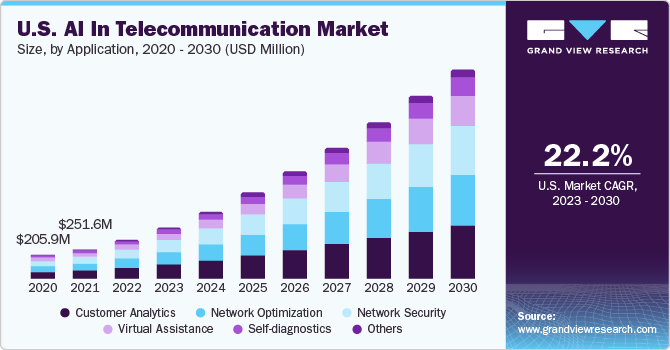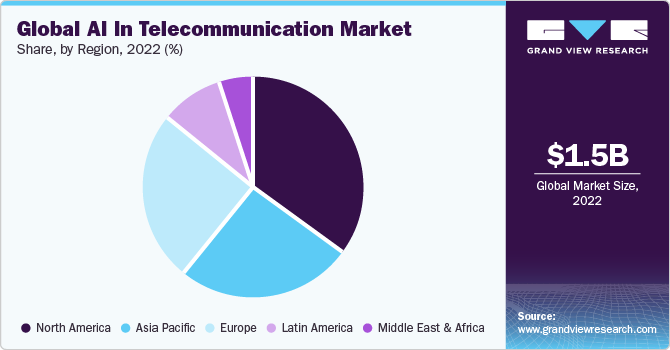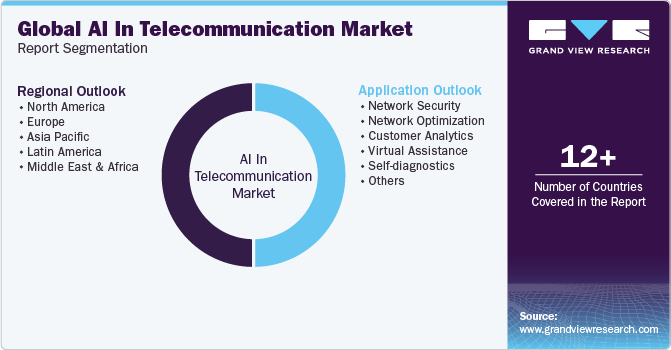- Home
- »
- Next Generation Technologies
- »
-
AI In Telecommunication Market Size & Share Report, 2030GVR Report cover
![AI In Telecommunication Market Size, Share & Trends Report]()
AI In Telecommunication Market Size, Share & Trends Analysis Report By Application (Network Security, Network Optimization, Customer Analytics, Virtual Assistance, Self-Diagnostics), By Region, And Segment Forecasts, 2023 - 2030
- Report ID: GVR-4-68038-247-1
- Number of Report Pages: 100
- Format: PDF, Horizon Databook
- Historical Range: 2017 - 2021
- Forecast Period: 2023 - 2030
- Industry: Technology
AI In Telecommunication Market Trends
The global AI in telecommunication market size was valued at USD 1.45 billion in 2022 and is anticipated to grow at a compound annual growth rate (CAGR) of 28.2% from 2023 to 2030. Telecommunications is one of the fastest-growing industries that use artificial intelligence (AI) in many aspects of their business, including improving customer experience and network reliability. Telecom companies use AI primarily for customer service applications. For instance, chatbots and virtual assistants address many installation, maintenance, and troubleshooting support requests. Also, virtual assistants scale and automate responses to support claims, improving customer experience and reducing business expenses. For instance, Vodafone Ltd. experienced about 68% improvement in customer experience after introducing its TOBi chatbot for handling customer queries.

By implementing AI and automation, telecom companies can reduce operational costs while improving the customer experience. Artificial intelligence has already helped the core of the telecommunication business, with machines doing human tasks, such as deciding the route traffic by reading network content. It also helps in building the self-optimizing network, which can structure the system based on existing conditions per the limits set by the respective designer. It supports network operations to detect issues, such as Service-Level Agreement (SLA) breaches, and diagnose the root causes.
Furthermore, growing Over-The-Top (OTT) services, such as video streaming, have transformed the dissemination and consumption of audio and video content. With more consumers turning to OTT services, consumer demand for bandwidth has grown considerably. Carrying such ever-growing traffic from OTT services leads to high operational Expenditure (OpEx) for the telecommunication industry. AI helps the telecom industry to reduce operational costs by minimizing the human intervention needed for network configuration and maintenance. Also, automation enables telecom companies to onboard customers faster while introducing new services in a shorter time.
The telecom industry is transitioning from the fourth generation (4G) to the fifth generation (5G) of mobile communications. 5G technology is expected to provide higher data transmission rates with ultra-low latency rates. Telecom companies are working to build an infrastructure supporting every vertical controlled by the Internet of Things (IoT). For instance, in March 2020, Google collaborated with AT&T Intellectual Property to help enterprises leverage Google Cloud’s technologies using the 5G network connectivity. Both companies are developing 5G solutions by combining the 5G network capabilities of AT&T Intellectual Property and Google Cloud’s capabilities in analytics, AI/machine learning, and networking.
The artificial intelligence in telecommunication value chain consists of AI solution providers, system integrators, and end-users. Each stage of the value chain is responsible for enhancing the product. Artificial Intelligence models and frameworks require several infrastructural facilities, technology tools, and data formats to train and implement machine learning and computer vision applications. Companies such as IBM Corporation, Microsoft, and Intel Corporation, among others, provide machine learning (neural network) tools for training on different aspects.
System integrators and infrastructure developers are vital in the artificial intelligence value chain. OEMs choose an appropriate system integrator with relevant knowledge, experience, and resources to provide comprehensive customer support and predictive maintenance. A service contract with manufacturers offers several benefits to application industries regarding design, integration, and delivery. Factory-trained field technicians assist in installing and working on these solutions in the telecommunication industry. Manufacturers also provide value-added support, such as remote monitoring and self-diagnostics applications.
AI-enabled the telecom industry to extract actionable business insights and boost customer experience. Predictive maintenance, network optimization, anomaly detection, robotic process automation (RPA), and fraud detection, among others, are some ways AI has contributed to the telecom industry. For instance, in May 2021, Nokia launched AVA Telco AI as a Service, which provides cloud-based artificial intelligence solutions and allows communication service providers (CSP) to automate capacity planning, network management, and service assurance.
The COVID-19 pandemic positively impacted Artificial Intelligence (AI) in the telecommunication market. The outbreak triggered a significant shift in consumer behavior and accelerated the digital transformation of the telecommunications industry. As people rely more on digital communication and remote services, the demand for AI-driven solutions in the telecommunication sector surged. One significant driver of the positive effect was the increased reliance on virtual communication tools and platforms.
Governments worldwide have realized the impact of 5G on digital transformation and are boosting the 5G rollout to drive AI and automation across the telecom industry. The fifth-generation technology is likely to drive digital transformation, the Internet of Things (IoT) powered by edge computing and AI across the wireless telecom sector. Increasing demand for higher quality services and seamless customer experience is likely to drive the adoption of AI in the telecom industry. Increasing 5G deployments are likely to create lucrative business opportunities for telecom operators to provide outsourced IT services and offer process automation services powered by edge computing and AI to enterprises. Many established telecom service providers, including Charter Communications, AT&T, and Verizon, are expected to invest significantly in AI.
Application Insights
Based on application, the market has been segmented into network security, network optimization, customer analytics, virtual assistance, self-diagnostics, and others. The customer analytics segment held the largest revenue share of 28.2% in 2022. The market growth of this segment is attributed to the growing need for real-time behavioral insights. Artificial intelligence enables operators to collect and analyze the customer's data from a subscriber's intelligencer perspective. This information can be further utilized in several scenarios, such as advertisements and personalized offers for the subscriber. Also, operators can use this information to achieve network optimization with better utilization of network resources.
The virtual assistance segment is expected to portray the fastest growth of 31.4% over the forecast period since customer service automation creates substantial savings for telecom companies. Also, customer support chatbots in the communication industry can be trained adequately as machine learning algorithms can automate inquiries and route customers to the optimal agent.
Regional Insights
North America dominated the market and accounted for the largest revenue share of 34.8% in 2022. Moreover, a growing number of telecom companies using automation and AI for customer service and network optimization purposes are expected to support the region’s growth. One of the significant drivers of growth in the North American segment is the presence of advanced telecommunications infrastructure. The region has robust network connectivity, including high-speed internet and widespread coverage, which creates a favorable environment for implementing AI solutions.
Post-COVID-19 pandemic, European telecom operators are observed to be prioritizing investments in AI to make more data-informed decisions. According to a report published by European Telecommunications Network Operators’ Association (ETNO) in February 2022, Europe recorded its highest investment in 5G and Fiber to the home (FTTH) network generating a capital expenditure (Capex) of approximately 72.21 billion in 2020. Significant investments will likely boost artificial intelligence (AI) adoption across the European telecom industry. On the contrary, the European telecom industry is highly regulated, likely leading to steady market growth across the region.

Asia Pacific is expected to grow at the fastest CAGR of 32.9% during the forecast period. This growth is attributed to the rapid technological advancements in emerging economies, such as China and India. For instance, Huawei Technologies Co., Ltd., a global telecommunications equipment and consumer electronics provider, cooperates with China Telecom Corporation Ltd., an internet access and mobile telecommunications services provider. This collaboration will explore radio cell capacity prediction and wireless network cell anomaly detection based on the Network AI Engine (NAIE).
The Middle East and Africa are likely the potential market for telecom service providers. The region has emerged as a forerunner in advanced networking in recent years, with Qatar, Saudi Arabia, Bahrain, and the UAE deploying 5G networks. In July 2021, Middle East telecom giants Zain Group, STC Group, Etisalat Group, du, and Mobily agreed to collaborate on deploying Open Radio Access Network (Open RAN) solutions to their existing networks. Such notable strategies will likely drive the demand for AI solutions in the telecommunication industry across the Middle East. South America is anticipated to show significant growth in the coming years. The European and U.S. markets mainly influence the South America telecom industry.
Key Companies & Market Share Insights
The artificial intelligence in telecommunication market players are undertaking strategies such as product launches, acquisitions, and collaborations to increase their global reach. For instance, in October 2022, Nokia, a multinational telecommunications, information technology, and consumer electronics company, introduced an AI maturity assessment to assist communication service providers in formulating and implementing effective AI strategies. This assessment is a valuable tool for communication service providers (CSPs) to optimize their utilization of autonomously driven software solutions. By leveraging these solutions, CSPs can enhance network quality, alleviate network congestion, and elevate the overall customer experience by offering innovative services and products.
Key AI In Telecommunication Companies:
- IBM Corporation
- Microsoft
- Intel Corporation
- Google LLC
- AT&T Intellectual Property
- Cisco Systems, Inc.
- Nuance Communications, Inc.
- Evolv Technologies Holdings Inc.
- H2O.ai.
- Infosys Limited
- Salesforce, Inc.
- NVIDIA Corporation
Recent Developments
-
In June 2023, Amdocs, an America-based software and services provider to communications and media companies, unveiled a telco generative AI framework called Amdocs amAIz. This innovative solution integrates carrier-grade architecture, harnessing open-source technology alongside large language AI models. By doing so, Amdocs amAIz establishes a robust foundation for global communications service providers, empowering them to unlock the vast capabilities of generative AI.
-
In February 2023, Bharti Airtel, an India-based telecommunication service provider, announced that it had built an AI solution in partnership with NVIDIA to improve the customer experience for its contact center from all inbound calls.
-
In September 2022, Amazon Web Services (AWS), an IT service management company, and SK Telecom, a telecommunications company, joined forces to develop a fresh range of computer vision services. This partnership simplifies and optimizes the process of constructing, utilizing, and expanding computer vision applications, ultimately boosting productivity, equipment maintenance, and facility safety for customers while reducing costs.
-
In November 2022, American Tower Corporation's African subsidiary revealed a strategic alliance with PowerX. The objective is to introduce PowerX's artificial intelligence (AI) solutions in the telecommunications sector of Africa to enhance energy efficiency and environmental advantages by optimizing energy consumption at tower locations.
-
In July 2022, Actifai, a software as a service provider, partnered with CSG, a customer engagement company. The collaboration aims to revolutionize customer acquisition for cable and telecommunications service providers by introducing an AI-powered offer recommendation solution. By seamlessly integrating Actifai's artificial intelligence software, ACP customers and their care agents can enhance average revenue per user (ARPU), achieve higher sales conversions, and improve customer sales and support experience. This partnership aims to leverage Actifai's AI software to boost average revenue per user.
AI In Telecommunication Market Report Scope
Report Attribute
Details
Market size value in 2023
USD 1.99 billion
Revenue forecast in 2030
USD 11.29 billion
Growth rate
CAGR of 28.2% from 2023 to 2030
Base year for estimation
2022
Historical data
2017 - 2021
Forecast period
2023 - 2030
Report updated
November 2023
Quantitative units
Revenue in USD million and CAGR from 2023 to 2030
Report coverage
Revenue forecast, company ranking, competitive landscape, growth factors, and trends
Segments covered
Application, region
Regional scope
North America; Europe; Asia Pacific; Latin America; Middle East & Africa
Country scope
U.S.; Canada; U.K.; Germany; France; China; Japan; India; Australia; South Korea; Brazil; Mexico; Saudi Arabia; South Africa; UAE
Key companies profiled
IBM Corporation; Microsoft; Intel Corporation; Google LLC; AT&T Intellectual Property; Cisco Systems, Inc.; Nuance Communications, Inc.; Evolv Technologies Holdings Inc.; H2O.ai.; Infosys Limited; Salesforce, Inc.; NVIDIA Corporation
Customization scope
Free report customization (equivalent up to 8 analyst’s working days) with purchase. Addition or alteration to country, regional & segment scope
Pricing and purchase options
Avail customized purchase options to meet your exact research needs. Explore purchase options
Global AI In Telecommunication Market Report Segmentation
This report forecasts revenue growth at global, regional, and country levels and provides an analysis of the latest industry trends in each of the sub-segments from 2017 to 2030. For this study, Grand View Research has segmented the global AI in telecommunication market report based on application, and region:

-
Application Outlook (Revenue, USD Million, 2017 - 2030)
-
Network Security
-
Network Optimization
-
Customer Analytics
-
Virtual Assistance
-
Self-Diagnostics
-
Others
-
-
Regional Outlook (Revenue, USD Million, 2017 - 2030)
-
North America
-
U.S.
-
Canada
-
-
Europe
-
U.K.
-
Germany
-
France
-
-
Asia Pacific
-
China
-
Japan
-
India
-
Australia
-
South Korea
-
-
Latin America
-
Brazil
-
Mexico
-
-
Middle East and Africa
-
Saudi Arabia
-
South Africa
-
UAE
-
-
Frequently Asked Questions About This Report
b. The global artificial intelligence (AI) in telecommunication market size was estimated at USD 1.45 billion in 2022 and is expected to reach USD 1.99 billion in 2023.
b. The global AI in telecommunication market is expected to grow at a compound annual growth rate of 28.2% from 2023 to 2030 to reach USD 11.30 billion by 2030.
b. North America dominated the AI in telecommunication market with a share of 34.8% in 2022. This is attributable to the fact that North America is one of the early adopters of AI technologies and has a growing number of telecom companies using automation and artificial intelligence for customer service and network optimization purposes.
b. Some key players operating in the artificial intelligence in telecommunication market include IBM Corporation; Microsoft; Intel Corporation; Google; AT&T Intellectual Property; Cisco Systems; Nuance Communications, Inc.; Evolv Technology Solutions, Inc.; H2O.ai; Infosys Limited; Salesforce.com, inc.; and NVIDIA Corporation.
b. Key factors that are driving the market growth include the growing need for customer analytics, rapid penetration of AI and machine learning, and growing R&D spending on the development of self-optimizing networks across the world.
Share this report with your colleague or friend.
![gvr icn]()
NEED A CUSTOM REPORT?
We can customize every report - free of charge - including purchasing stand-alone sections or country-level reports, as well as offer affordable discounts for start-ups & universities. Contact us now
![Certified Icon]()
We are GDPR and CCPA compliant! Your transaction & personal information is safe and secure. For more details, please read our privacy policy.
We are committed towards customer satisfaction, and quality service.
"The quality of research they have done for us has been excellent."





